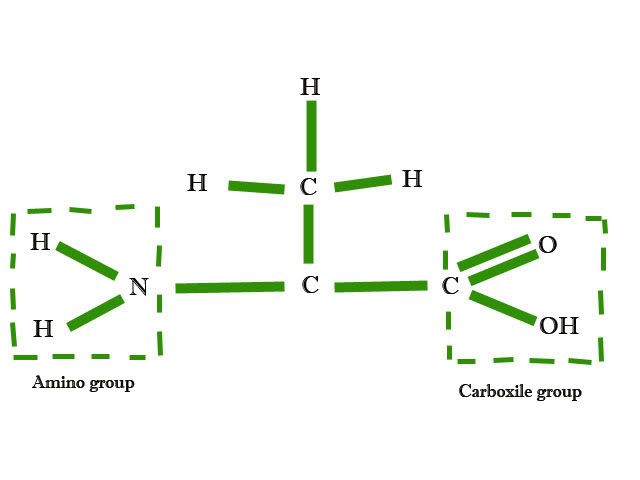Proteins have complex chemical structure, and
they are contained of carb, oxygen, hydrogen and nitrogen. These four elements
enter the composition of all amino acids that build proteins.
Twenty amino-acids in the body of human enters
the protein building that are part of various tissues, hormones, enzymes,
neurotransmitters and other important substances.
Each amino-acid has amino(NH2) and
carboxile(COOH) group, that give puffer properties to acids, which structure
are they a part of.
Amino-acids are mutually connected in proteine
molecule with PEPTID CONNECTIONS. Combinations of amino-acids in proteine
molecules can be various, what is important for numerous functions of protein
in organism. Number of amino-acids in proteins can be over 300(highmolecular
polypeptides).
All of the amino-acids can be shared into
essential and non-essential. Essential amino-acids can’t be synthetized in
organism, so they have to be taken daily by food. From 20 amino-acids, 8 are
essential. In childhood essential acids are also histidine and arginine,
because they are not synthetized quick enough, or in amount that is necessary
for intensive processes of growth in this part of life.
Essential amino-acids have to be present at the
same time in organism to synthetize necessary proteins in different tissues. In
reversed case synthesis will be stopped, and present amino-acids will be
degradated and used on the other way.
Essential and non-essenital amino-acids
Essential:
histidine, fenilalanine, isoleucine, lysine, methionine, treonine, tryptophan,
valine, leucine
Non-essential: alanine, cysteine, glycine, arginine,
asparagine, cystine, proline, serine, aspartat acid, glutamine acid, glutamine,
tyrozine
Groceries that enable protein intake
Proteins that are present in animal food
contain all essential amino-acids in proportions that are the most favorable
for usage in digestive tract, liver and other tissues, so they are often called
high-quality proteins.
Plant proteins often don’t contain all
essential amino-acids; most often three amino-acids have lower concentration:
lysine, tryptophane and metionine. By good chose of vegetables, at athletes in
which nutrition plant food dominates(vegetarians), satisfable intake of all
amino- acids can be achieved.
Groceries that belong to two groups(pyramid
model): milk and milk products, as the group meat, contain in their composition
important amount of high value proteins. High proteine amount is also found in
peas and beans grain, just as in stone fruit. Generally, vegetables, fruit and
grain food contain proteins in their composition; but their content is small
and it varies. In table below groceries are shown by groups and contain of
proteins varies inside of them; good combination of groceries from various
groups enables satisfactive intake of proteins.
Protein
amount in some groceries
|
||
Groceries
|
Portion
size
|
Proteins(g)
|
Meat,
fish, chicken
|
120 g cooked
|
30
|
Egg
|
one big
|
7
|
Tuna
|
450g can
|
40
|
Beans,
legumes
|
1 cup
|
7
|
Peanuts
butter
|
2 spoons
|
9
|
Soya,
cheese
|
120g
|
10
|
Milk
or yoghurt
|
240g
|
8-10
|
Cheese,
hard
|
30g
|
7
|
Rice,
pasta, potatoes, dumplings
|
1 cup
|
2
|
Bread
|
1 piece
|
2
|
Peas,
carrot, corn, beet root
|
1 cup
|
2
|
Fruit
|
1 piece
|
<1
|
Animal
groceries contain high amount of high quality proteins, that at the same time
contain a lot of fat. So it should be selective with food chosing and food
preparation.
Protein digestion starts in gastric, and it is
continued in intestinals under influence of pancreas enzymes. Then it comes to
protein separation to polypeptids, and in the end amino acids. Amino-acids,
built in the process of digestion, are absorbed in intestinals, and then through
blood come to liver, where the most significant part of metabolism is done. In
liver amino-acids are constantly synthetized, and they are used in synthesis
processes in various tissues.
If amino-acids are not used for the process of
protein synthesis, their further metabolism can flow in various ways:
- Separating amino-group(NH2) (disamination), fat acid is
being created, which can be used in Krebs cycle for energy gaining.
- The rest that is created by disamination can be used for synthesis
of some carbohydrate or fat.
- Amino-group, created by disamination, can be used for new
amino-acids synthesis from the existing ones.
- Amino-group, in chemical reaction with water and carbon dioxide,
builds urea that is secreted
through urine. Amino-group can also take part in the build of ammonium
salts that serve as a part of puffer system in kidney, or it is secreted
from the organism through kidney.
Protein role in organism
The most important functions of proteins are:
- Influence in various tissues(organs) creating.
- Forming structural base for all enzymes in organism that control
the speed of chemical reactions development.
- Build antibodies.
- Build chormones.
- Help in water balance maintaining.
- Their chemical structure and huge representation in organism makes
them the most significant factor for maintaining acid-base balance.
- Helping in process of blood cells forming.
- Transport role is manifested in function of lipoproteins,
haemoglobin(oxygen and carbon dioxide transport) and other proteins that
take part in nutrients and metabolism products to various tissues
transport.
Daily protein intake at healthy people that do
not do any sport, should be 10-15% of maximum daily amount of calories.
Recommendations in the countries of western Europe are 54-105g for grown-up
males and 43-81g for females. In USA
Daily
protein needs dependant on age and type of physical activity
|
|
Number of grams by kg/BM
|
|
Standard,
RDA, sedentary, grown-ups
|
0,8
|
Recreatives,
grown-ups
|
1,0-1,5
|
Athletes,
competitiors, grown-ups
|
1,2-1,8
|
Adolescents,
athletes
|
1,6-1,8
|
Muscle
mass build, grown-ups
|
1,4-1,8
|
Athletes
on restrictive energy intake
|
1,6-1,8
|
Maximal
grown-up amount
|
1,8
|
"Athletes' nutrition", Marina Djordjevic Nikic










0 коментара:
Постави коментар